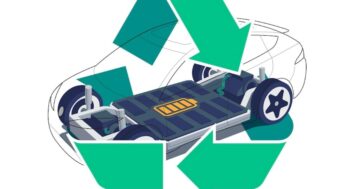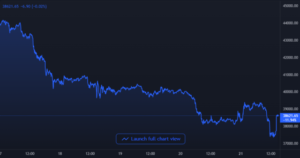
This article is sponsored by Eaton.
Since transportation continues to be the largest-emitting sector when it comes to greenhouse gas, the focus on electrification is heating up.
Growth in electric car sales has been substantial, rising 168 percent in the first half of 2021 compared to 2020 — with particularly strong sales in China and Europe due to government mandates and emissions standards. Additionally, more than a dozen countries have announced zero-emission vehicle targets or the phaseout of internal combustion engine vehicles in the next two decades.
This week at COP26, decarbonization of the transportation sector was a major focus. But while the world is well on its way to making advancements in electric vehicle technology, there’s one key piece of the decarbonization effort still left to tackle: heavy-duty vehicles.
Long-haul trucks and construction vehicles, known for running long hours and for many hundreds of miles at a time, represent more than 20 percent of transportation emissions. And the path to decarbonization for these vehicles is much bumpier, due to the large amount of electrical energy needed to fulfill their job. Where powering a car battery at a charging station is sufficient to run your personal electric car, heavy-duty vehicles would require enormous batteries and several hours of charge time to store more than 50 times that energy.
Even with the latest ultra-fast charging technology, an electric heavy-duty vehicle would gain a mere two to three miles of range per minute of charge time. To put that in perspective, refueling with diesel fuel adds up to 100 miles per minute. In short, electrification alone isn’t the answer to decarbonization. Where there’s promise, however, is with hydrogen.
The promises and challenges of hydrogen fuel cells
One viable solution to decarbonize heavy-duty, long-haul vehicles today is through green hydrogen. The transportation industry was successful in using hydrogen solutions for light-duty vehicles, however, simply scaling the technology for heavy-duty vehicles is not as straightforward.
Scaling fuel cells for heavy applications sets new and very different requirements in terms of life, efficiency and cost. Eaton, however, is providing exciting solutions in each area:
1. Getting the right airflow
A fuel cell is an energy conversion device that produces electricity by combining hydrogen and oxygen into water. The precise flow of oxygen into the fuel cell, however, is critical as it controls the electrical production — and can be a big challenge.
That’s where Eaton comes in. Eaton has been at the forefront of air controller technology with its electrically driven air pumps for more than 20 years. Because of its expertise, Eaton is partnering with the U.S. Department of Energy to continue making advancements in this space.
The air pump is the largest electrical consumer inside a fuel cell, with about 15-20 percent of the electrical production used to power the pump. That’s why Eaton is working to reduce the amount of electricity the air controller uses by half.
Achieving this level of efficiency without sacrificing performance, while simultaneously increasing durability and maintaining an acceptable cost, is a key part of the Department of Energy‘s “Hydrogen Earthshot” program to adapt fuel cells for heavy-duty, long-haul truck needs.
2. Precise hydrogen control
In addition to controlling the airflow, Eaton is also examining the hydrogen supply side of the fuel cell. Traditional hydrogen supply systems trade off cost and durability for performance and efficiency. Introducing innovation in the hydrogen circuit, Eaton’s approach is able to efficiently and precisely control the flow entering the fuel cell and recirculate the excess.
By being precise, we avoid wasting hydrogen and thus further improve overall efficiency. These solutions are not just relevant to heavy-duty, on-road vehicles but may also lead to advancements in decarbonizing aircraft propulsion.
3. Managing electrical power
Most light-duty hydrogen vehicles use a small fuel cell to charge a large battery that, in turn, drives an electric motor. This concept works well because cars have a relatively low average power draw and only need high power for short amounts of time. The electrical system is also simple because the fuel cell doesn’t interact directly with the motor.
But scaling that concept to heavy-duty trucks would result in extremely large batteries — about five times as large as EV car batteries. For trucks, the ideal solution is a fuel cell that operates efficiently at all power levels and uses a much smaller battery only for starting and storing brake energy.
However, this presents a new challenge: The electrical system must become much more complex as it needs to blend power from three sources: the fuel cell; the battery; and the electric motor. This is, again, a well-known space for Eaton, which has extensive microgrid experience in managing electrical power in similar settings. And Eaton is reapplying that know-how in hydrogen vehicle applications, to ultimately reduce the need for batteries.
By manipulating the fuel cell electrical generation, the smaller battery and the electrical powertrain, Easton is aiming to reduce the battery size in a heavy-duty vehicle by a factor of three to five. This not only reduces the upfront costs of the vehicle but also its weight, in turn improving the freight capacity of a fuel cell truck.
Decarbonizing from all angles
It’s clear that green hydrogen will play a critical role in a net-zero future. It releases zero carbon emissions and can be produced from renewable sources. And while there are still challenges to overcome, Eaton is helping pave the way. These challenges fall right into the company’s sweet spot: the convergence of electrical and mechanical power.
Eaton’s work in this space is also in alignment with the company’s mission — to improve the quality of life and the environment — and with its ambitious, science-based 2030 Sustainability Targets. Eaton has committed to reducing its Scope 3 carbon emissions from it technologies and throughout its value chain by 15 percent by 2030. And to spend $3 billion in research and development for sustainable solutions in that same timeframe.
Eaton’s expertise in vehicle and powertrain controls, combined with its experience in managing gas and electrical flows, will help develop efficient, reliable, safe and cost-effective zero-emissions solutions for the future.
Source: https://www.greenbiz.com/article/decarbonizing-heavy-duty-transportation-hydrogen-answer








